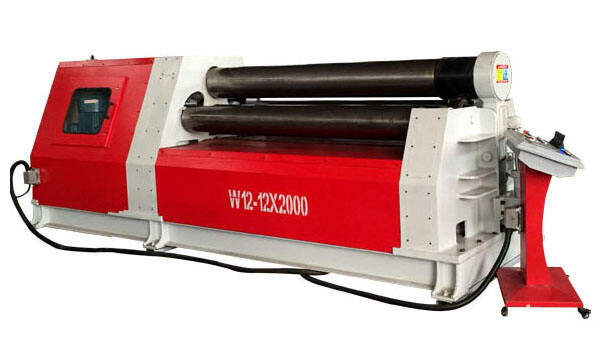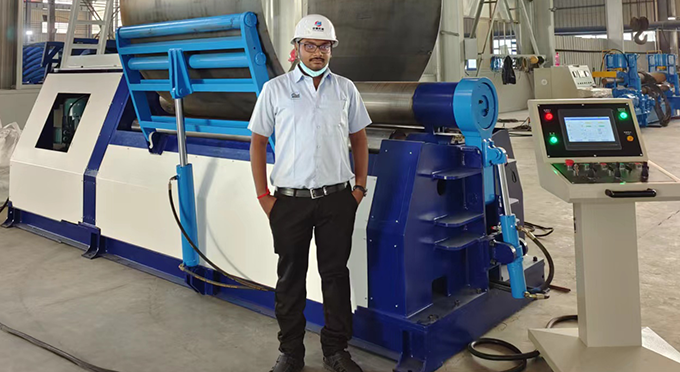Understanding Manual vs. Automatic Plate Bending Rolls
Core Principles of Manual Plate Bending Rolls
Manual plate bending rolls are foundational in metalwork for their emphasis on operator skill and tactile manipulation. These machines rely heavily on the experience of the operator, who must deftly adjust the rolls to shape metal into desired arcs or curves. Ideal for custom projects, they offer nuanced control where every subtle adjustment counts. Operators can select the roll configuration best suited to the task, impacting the accuracy and finish of the bend significantly. With manual operations, there is the flexibility to make incremental changes, catering to the specific material properties like yield strength and thickness, making these machines invaluable in smaller-scale, detail-oriented metal fabrication projects.
Core Principles of Automatic Plate Bending Rolls
Automatic plate bending rolls revolutionize the bending process by incorporating CNC technology, which brings precision and consistency to metalworks. These machines reduce physical labor, allowing operators to program complex bending profiles, which markedly improves production efficiency, especially in large-volume projects. With integrated sensors and feedback mechanisms, these automatic systems make real-time adjustments, optimizing performance and minimizing material waste. Unlike manual systems, less experienced operators can run these machines effectively, as the main skill required is programming the machine. As a result, automatic plate bending rolls are increasingly popular in various manufacturing settings due to their advanced technological control and ease of operation.
Key Differences in Operation and Control
The most significant difference between manual and automatic plate bending rolls is in their operation and control mechanisms. Manual systems are highly operator-dependent, requiring constant human oversight, whereas automatic systems leverage technological advancement, emphasizing computerized control. Manual machines are ideal for tailor-made, one-off custom jobs, providing flexibility for unique projects. On the other hand, automatic systems are designed for high-volume production, ensuring uniformity and faster operation thanks to reduced human intervention. Moreover, automated systems typically exhibit a lower error margin due to their computerized precision, making them the preferred choice for projects that demand strict tolerances and high accuracy operation speeds.
Key Advantages and Limitations
Benefits of Manual Plate Rolling Machines
Manual plate rolling machines are prized for their affordability, often making them the optimal choice for small shops and startup fabricators. They are less expensive upfront compared to automated systems, providing an accessible entry point for operations with budget constraints. Maintenance is also more straightforward, owing to the absence of complex electronic components, which reduces both costs and downtime. Their flexibility is a standout attribute, allowing quick adjustments to accommodate a variety of custom projects. In instances where unique shapes or intricate designs are needed, these machines offer tactile feedback, empowering operators to make immediate adjustments and achieve desired outcomes efficiently.
Benefits of CNC Plate Bending Machines
CNC plate bending machines are synonymous with enhanced productivity and precision. They are geared to operate continuously without fatigue, which substantially raises output rates and diminishes downtime. Precision is a defining characteristic of CNC technology, ensuring that bends meet tight tolerances with consistent repeatability over extensive production runs. These machines can rapidly churn out intricate and complex designs, eliminating the time-intensive setups associated with manual systems. Furthermore, the automation inherent in CNC machines reduces the likelihood of human error, thereby cutting down scrap rates and minimizing material costs over time.
Drawbacks of Manual Systems for Complex Projects
While manual systems offer several benefits, they encounter challenges in handling complex projects due to precision issues. The reliance on human skill can lead to inconsistencies and potential material waste when exact specifications are crucial. Training and skilled labor are pivotal, as inexperienced or less-experienced operators might compromise the quality of bends. In larger scale production, the manual systems fall short in speed compared to automated alternatives, resulting in escalated labor costs per unit. Additionally, the physical strain placed on operators can lead to fatigue, which in turn, diminishes productivity and raises safety concerns.
Limitations of Automatic Systems in Small-Scale Operations
Automatic systems, while efficient, also have limitations, especially for small-scale operations. The initial cost for acquiring CNC plate bending machines can be significant, which might be a deterrent for smaller businesses. Moreover, the complexity of programming such systems could necessitate external expertise if in-house capabilities are lacking, potentially offsetting the automation's benefits. Unlike manual systems that can swiftly adjust to new tasks, automatic systems may have reduced agility, as reprogramming can be time-consuming. In scenarios with low production volume, the operational costs per unit can increase due to prolonged machine operation without reaching production economies of scale.
Factors to Consider When Choosing Between Manual and Automatic Systems
Material Thickness and Yield Strength
When deciding between manual and automatic systems, considering material thickness and yield strength is paramount. Heavier materials, like those used in heavy-duty industrial applications, often necessitate more robust equipment, such as a hydraulic plate bending machine. Automatic machines are better equipped for handling repeated flattening and bending of thicker materials, minimizing structural risks and ensuring uniform results. Evaluating the required bending radius is also critical, as some systems may be more appropriate for specific dimensional constraints, ensuring optimal results. Regular testing on material stress under different bending parameters is necessary to make informed equipment choices.
Production Volume and Efficiency Requirements
Assessing anticipated production volume is crucial, as automatic systems typically provide higher efficiency and lower operational costs for high-volume projects. For occasional or custom jobs, though, manual systems might suffice, avoiding the overhead costs associated with automated machinery. Efficiency is not solely about speed, as it also entails setup times; automated machines often require longer setups when customization is needed, impacting productivity. Hence, long-term forecasts of production needs, including scalability and flexibility considerations, are imperative for an informed decision.
Pre-Bending Needs and Minimum Diameter Constraints
Pre-bending processes may be vital depending on material and specifications, significantly affecting machine choice. Automatic systems, such as CNC plate bending machines, are often equipped to handle pre-bending more efficiently, requiring fewer steps for intricate bends. Minimum diameter constraints vary between manual and automatic systems, which must be considered as each has specific capacities that might influence their suitability for different projects. Keeping future projects in mind while evaluating potential changes in bending needs can guide decisions on system investment.
Budget vs. Long-Term ROI Analysis
Calculating the upfront budget against potential long-term returns is imperative in choosing the right system. Automatic systems, though expensive initially, offer notable efficiency benefits over time. Analyzing operational and maintenance costs and potential workforce changes helps in understanding overall cost-effectiveness. Comprehending production goals and trends further aids in projecting future needs, sharping investment decisions. Engaging with financial advisors or industry experts can yield invaluable insights into long-term ROI and ensure cost-effective purchases.
Applications Across Industries
Manual Rolls in Custom Fabrication Shops
Custom fabrication shops frequently depend on manual plate bending rolls to craft intricate designs, offering operators significant control and precision. This level of manual interaction allows for immediate adjustments, making it ideal for projects requiring bespoke solutions. Industries such as art, architecture, and specialized manufacturing immensely benefit from these customizable capabilities. With their affordability and simplicity, manual rolls provide an excellent entry point for startups or smaller operations into the world of manufacturing, fostering creativity and innovation in new businesses.
Automatic Hydraulic Plate Bending Machines for High-Volume Output
In sectors like automotive and aerospace manufacturing, automatic hydraulic plate bending machines are indispensable due to their high efficiency in volume production. These machines can consistently deliver large quantities of materials, conforming to precise design specifications, thus maximizing operational output. Automation reduces labor costs significantly while enhancing product quality and minimizing production time. Furthermore, the flexibility to incorporate new programs ensures these machines can easily adapt to changing production lines with minimal downtime.
Three-Roll vs. Four-Roll Systems in Structural Projects
Selecting between three-roll and four-roll systems is crucial in structural projects, where design dictates ease of bending and material handling. Three-roll systems are generally simpler and less expensive, suitable for standard applications where precision is not paramount. Conversely, four-roll systems offer enhanced capabilities, especially for producing uniform results with thicker materials that demand more control and support. By conducting a detailed analysis of project requirements and material types, one can make an informed choice on the appropriate system, ensuring both efficiency and quality in structural applications.
Future Trends in Plate Rolling Technology
Integration of Dynamic Crowning Systems
Dynamic crowning technology stands out as a significant advancement in the realm of plate rolling, offering real-time adjustments in the bending process to enhance product quality. By addressing challenges such as deflection and bending inconsistencies across wide plates, this system ensures superior output. The automation of crowning adjustments not only reduces setup times but also allows operators to concentrate on complex production aspects without needing to manually tweak settings. Industry experts foresee that these innovations will soon be standard in high-end machines, influencing purchasing decisions as manufacturers seek these advanced features to stay competitive in quality and efficiency.
Hybrid Machine Capabilities for Versatility
The emergence of hybrid machines combining manual controls with CNC capabilities marks a new era of versatility in plate rolling technology. These machines seamlessly shift between automatic and manual modes, offering manufacturers the flexibility to tackle both intricate, customized projects and high-efficiency automated tasks. As industry demands become more diverse, these hybrid systems are poised to meet varying requirements across different applications and materials. By adopting this technology, manufacturers can achieve substantial cost savings and streamlined workflows, making these machines highly appealing for those seeking to enhance operational adaptability and efficiency.




